5G Positioning Principles and Application Scenarios
1. Introduction
With the continuous advancement of 5G network construction, industry customers have increasingly diverse demands for 5G functions, among which precise positioning has become a basic requirement for various industries. Application scenarios such as emergency rescue, connected vehicles, intelligent manufacturing, and smart logistics have higher requirements for positioning capabilities. Positioning capability is one of the core capabilities of 5G. The R16 protocol proposes a series of new positioning methods with sub-meter positioning accuracy, greatly expanding the application scenarios of positioning technology. As a leading provider of 5G base station solutions, SageRAN continues to research and layout cutting-edge technologies such as 5G positioning.
2. Evolution of 5G Positioning Technology
In the long-term evolution of communication positioning systems, the communication system positioning accuracy of the R9 to R11 protocols is not high, generally ranging from 50 to 150 meters, mainly based on observed time difference of arrival (OTDOA), UL-TDOA, and cell identification (CID). From the R12 to R14 protocols, the positioning accuracy reached 10 to 100 meters, and multiple positioning technology fusion schemes were proposed. Until the R15 and R16 protocols, 5G constructively proposed using the multi-beam characteristics of multiple-input multiple-output (MIMO) for positioning enhancement, and also defined positioning technologies based on cellular RTT, DL TDOA, arrival angle (AOA), departure angle (AOD), etc., achieving positioning accuracy of 3 to 10 meters. On this basis, the technology continues to evolve, and the R17 protocol will further improve indoor positioning accuracy to the centimeter level to meet the needs of specific vertical industry application scenarios.
3. R16-defined 5G Positioning Technology
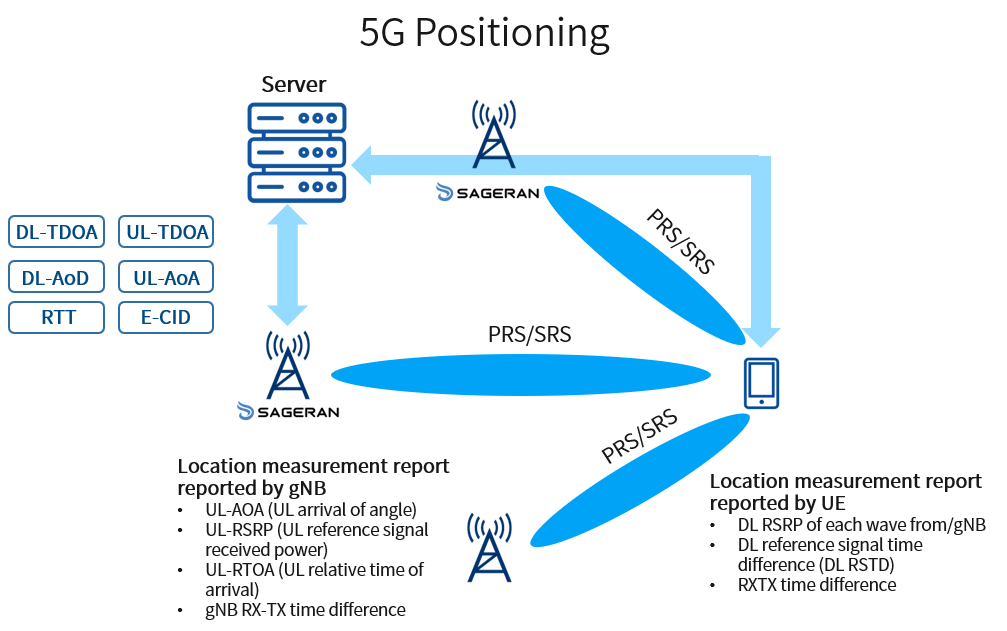
Figure 1: 5G Positioning Technology Defined in R16
In the R16 protocol, 3GPP has defined the positioning accuracy and end-to-end positioning latency of 5G positioning: the positioning accuracy in both horizontal and vertical dimensions is less than 3 meters (for 80% of users in the area), and the end-to-end latency is less than 1 second. To achieve this accuracy and latency, the main positioning technologies adopted by 3GPP include DL-TDOA, UL-TDOA, UL-AOA, and Multi-RTT.
4. Techniques Used in 5G Positioning
·DL-TDOA
The terminal measures the time difference of arrival (RSTD) of the downlink positioning reference signal (PRS) sent by two base stations, reports it to the location server, and the location server estimates the terminal position based on the time difference of multiple downlink reference signals.
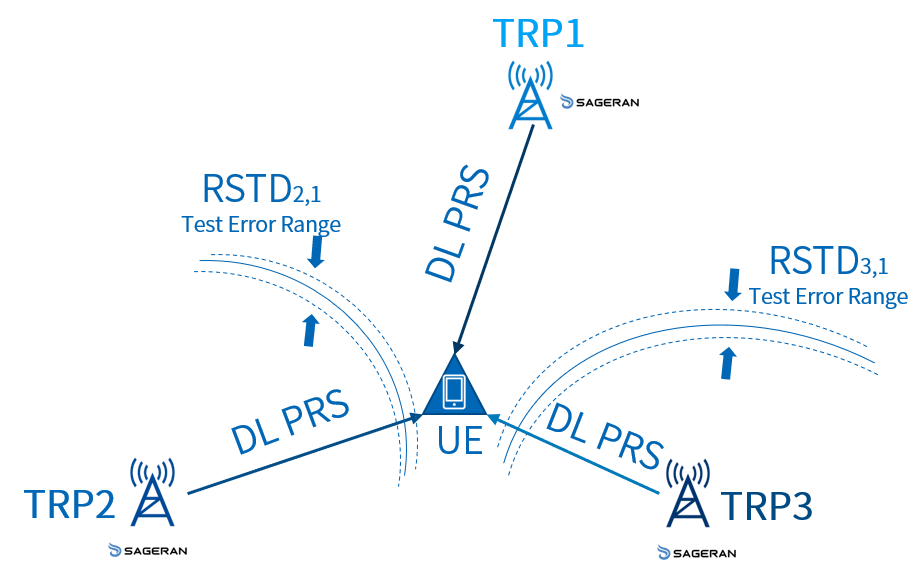
Figure 2: DL-TDOA Positioning Principle
UL-TDOA
Similar to DL-TDOA, but this is a positioning technology based on uplink signals. The base station measures the uplink relative time of arrival (UL RTOA) of the enhanced detection reference signal (SRS) received by multiple TRPs at different locations, reports it to the location server, and the location server determines the terminal's position.
·DL-AoD
The terminal measures and reports the received power of the downlink reference signal beam (i.e., the DL RSRP of each base station's beam) and estimates the terminal's position angle based on the direction of the transmitted beam. The location server solves the equation group based on the estimated values from multiple base stations to obtain the terminal position.
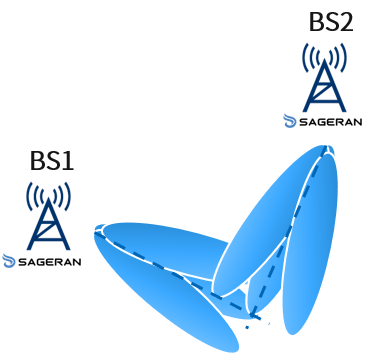
Figure 3: DL-AoD Positioning Principle
·UL-AoA
Similar to DL-AoD, but this is a positioning technology based on uplink signals. Multiple base stations measure the angle of arrival of the terminal's uplink signal, report it to the location server, and the location server solves the equation group based on the measured angles from multiple base stations to obtain the terminal position.
·Multi-RTT
The terminal and at least three base stations exchange reference signals, and both the base station and the terminal calculate their own Rx-Tx time difference. The sum of the two is the round-trip time (RTT), and the distance between the UE-TRP is 0.5RTT * speed of light. The intersection of the three UE-TRPs is the terminal position. The Rx-Tx information is aggregated to the location server to obtain the terminal position estimate.
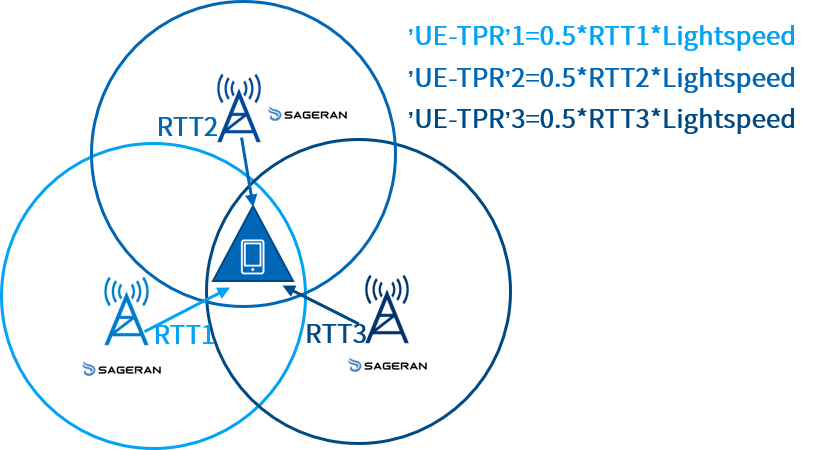
Figure 4: Multi-RTT Positioning Principle
·E-CID
The terminal wirelessly measures the reference signal of the base station and reports the measurement indicators of RSRP/RSRQ to the location server. The location server estimates the RTT based on the path loss of the wireless measurement indicators, combines the position of the base station antenna TRP, and locates the terminal through the intersection of multiple circles or the direction of the beam and the intersection of the circle. The advantage of this scheme is that it does not require the introduction of new reference signals, but it may result in insufficient positioning accuracy.
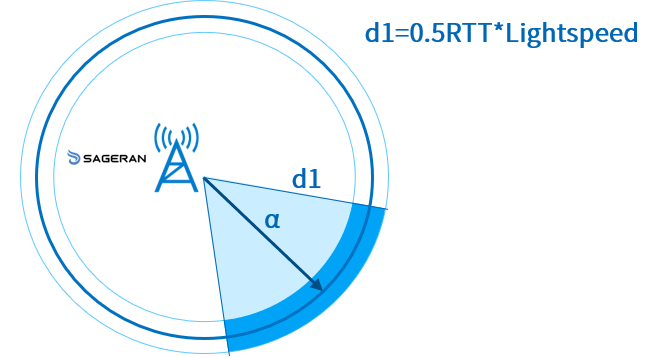
Figure 5: E-CID Positioning Principle
5. Comparison of 5G Positioning with Other Positioning Technologies
Compared with GNSS positioning, 5G positioning can achieve outdoor positioning through macro base stations and indoor positioning through small indoor base stations, while providing high-quality wireless access to users and synchronizing indoor and outdoor positioning. 5G positioning greatly expands the positioning scenarios and provides a new choice for a large number of indoor positioning needs.
Compared with beacon-based positioning technologies such as Bluetooth and UWB, 5G positioning does not require the deployment of a large number of beacon stations. Only a small number of 5G base stations need to be deployed to achieve positioning, and in the future, it will also achieve accuracy and position update cycles similar to beacon-based positioning. 5G positioning reduces deployment difficulty and greatly compresses deployment cycles.
6. Application Scenarios of 5G Positioning
According to the specifications for NR positioning use cases and requirements in the 3GPP R16 protocol, the application scenarios of 5G positioning can be roughly divided into the following three categories:
A. Emergency positioning
5G positioning plays an important role in emergency rescue. In emergency services, users can seek help by contacting Public Safety Answering Points (PSAP) and requesting accurate positioning information to provide timely assistance. Especially in special places such as underground mines, high-precision wireless positioning can accurately grasp the location of trapped personnel and real-time control the distribution of rescue forces, thereby flexibly deploying rescue work and improving rescue efficiency.
In addition, in situations such as fires and medical emergencies, 5G emergency positioning technology can quickly locate the position of the alarm or rescue personnel, providing timely and accurate information for rescue operations and helping to ensure the safety of people's lives and property.

Figure 6: Emergency positioning scenario
B. Personal Positioning
5G high-precision positioning services are not only suitable for emergencies, but also support a large number of personal services, including outdoor and indoor scenarios, and can support high-precision positioning services in traffic roads, tunnels, underground parking lots, or indoor environments. In these areas, high-precision positioning services based on 5G networks become particularly important due to the small coverage range of satellite signals.
In addition to the above weak signal coverage scenarios, 5G network's high-precision positioning can also be applied to locating shared bicycles, setting up parking electronic fences, enabling AR applications based on user location, implementing power-saving strategies for wearable devices based on user location, location-based advertising, traffic flow analysis, etc. The implementation of these services relies on high-precision positioning services to provide stable and reliable network support.

Figure 7: Personal positioning scenario
C. Vertical Industries
5G positioning technology is suitable for various vertical industries, such as industry, transportation, ports, medical, logistics, etc. In the industrial field, 5G high-precision wireless positioning technology can greatly improve management efficiency and operational efficiency, achieve intelligent warehousing, production process tracking, automatic cargo handling and processing, and achieve the goal of reducing costs and increasing efficiency. In crowded places such as airports (stations), shopping malls, hospitals, etc., 5G indoor high-precision positioning technology can provide efficient guidance services and dynamic analysis methods, helping managers improve operational efficiency and promote the intelligent and digital transformation of various industries.

Figure 8: Vertical positioning scenario
7. Conclusion and Prospects
With the deepening of 5G network construction, more accurate 5G positioning will become a catalyst for 5G business and application, bringing infinite possibilities to the construction of smart cities and various industries. SageRAN will continue to invest in the exploration and innovation of 5G positioning technology, closely follow the landing of industry applications, and empower the intelligent city ecosystem!










